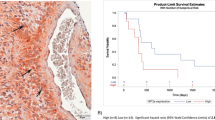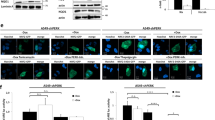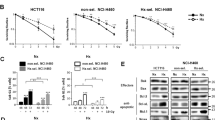Abstract
We have previously shown that the antiepidermal growth factor receptor monoclonal antibody cetuximab (C225; Erbitux), which was recently approved for the treatment of metastatic colorectal cancer, has antiangiogenic properties, inhibiting vascular endothelial growth factor (VEGF) secretion in culture and in animal models. Here, we have furthered the study by demonstrating that cetuximab reduces cellular levels of hypoxia-inducible factor-1 alpha (HIF-1α), a transcriptional regulator of VEGF expression, in A431 epidermoid carcinoma cells under both normoxic and hypoxic culture conditions. Expression of a constitutively active Ras in A431 cells rendered cellular resistance to the cetuximab-mediated reduction of the HIF-1α level. Cell lines with naturally occurring phosphatase and tensin homologue deleted on chromosome 10 mutations or deletions were also resistant to cetuximab-mediated reduction of the HIF-1α level. Pharmacologic inhibition of phosphatidylinositol 3-kinase with LY294002 reduced the HIF-1α level in both normoxic and hypoxic A431 cells, whereas inhibition of the mitogen-activated protein kinase kinase by PD98059 reduced the level of HIF-1α only in normoxic A431 cells. In addition, cetuximab reduced the cellular level of HIF-1α in the presence of a proteasome inhibitor, lactacystin, indicating that cetuximab acts mainly at the level of protein synthesis. The reduction of HIF-1α in response to cetuximab treatment was accompanied by transcriptional inhibition of VEGF expression, measured by a luciferase assay in A431 cells transfected with a vector containing the VEGF hypoxia response element. Taken together, our results indicate that the previously demonstrated inhibition of VEGF by cetuximab occurs at the level of transcription in response to a reduced level of HIF-1α and justify further testing of therapeutic strategies that combine cetuximab with approaches inhibiting the function of VEGF or the VEGF receptor.
This is a preview of subscription content, access via your institution
Access options
Subscribe to this journal
Receive 50 print issues and online access
$259.00 per year
only $5.18 per issue
Buy this article
- Purchase on Springer Link
- Instant access to full article PDF
Prices may be subject to local taxes which are calculated during checkout






Similar content being viewed by others
References
Albanell J, Codony-Servat J, Rojo F, Del Campo JM, Sauleda S, Anido J, Raspall G, Giralt J, Rosello J, Nicholson RI, Mendelsohn J and Baselga J . (2001). Cancer Res., 61, 6500–6510.
Alvarez-Tejado M, Naranjo-Suarez S, Jimenez C, Carrera AC, Landazuri MO and del Peso L . (2001). J. Biol. Chem., 276, 22368–22374.
Arany Z, Huang LE, Eckner R, Bhattacharya S, Jiang C, Goldberg MA, Bunn HF and Livingston DM . (1996). Proc. Natl. Acad. Sci. USA, 93, 12969–12973.
Bacus SS, Altomare DA, Lyass L, Chin DM, Farrell MP, Gurova K, Gudkov A and Testa JR . (2002). Oncogene, 21, 3532–3540.
Beitner-Johnson D, Rust RT, Hsieh TC and Millhorn DE . (2001). Cell Signal., 13, 23–27.
Bianco R, Shin I, Ritter CA, Yakes FM, Basso A, Rosen N, Tsurutani J, Dennis PA, Mills GB and Arteaga CL . (2003). Oncogene, 22, 2812–2822.
Blancher C, Moore JW, Robertson N and Harris AL . (2001). Cancer Res., 61, 7349–7355.
Blancher C, Moore JW, Talks KL, Houlbrook S and Harris AL . (2000). Cancer Res., 60, 7106–7113.
Chen C, Pore N, Behrooz A, Ismail-Beigi F and Maity A . (2001). J. Biol. Chem., 276, 9519–9525.
Ciardiello F, Bianco R, Damiano V, Fontanini G, Caputo R, Pomatico G, De Placido S, Bianco AR, Mendelsohn J and Tortora G . (2000). Clin. Cancer Res., 6, 3739–3747.
Clarke K, Smith K, Gullick WJ and Harris AL . (2001). Br. J. Cancer, 84, 1322–1329.
Cohen MH, Williams GA, Sridhara R, Chen G, McGuinn Jr WD, Morse D, Abraham S, Rahman A, Liang C, Lostritto R, Baird A and Pazdur R . (2004). Clin. Cancer Res., 10, 1212–1218.
Cunningham D, Humblet Y, Siena S, Khayat D, Bleiberg H, Santoro A, Bets D, Mueser M, Harstrick A, Verslype C, Chau I and Van Cutsem E . (2004). N. Engl. J. Med., 351, 337–345.
Fan Z, Baselga J, Masui H and Mendelsohn J . (1993a). Cancer Res., 53, 4637–4642.
Fan Z, Masui H, Altas I and Mendelsohn J . (1993b). Cancer Res., 53, 4322–4328.
Fan Z and Mendelsohn J . (1998). Curr. Opin. Oncol., 10, 67–73.
Feldser D, Agani F, Iyer NV, Pak B, Ferreira G and Semenza GL . (1999). Cancer Res., 59, 3915–3918.
Folkman J and Shing Y . (1992). J. Biol. Chem., 267, 10931–10934.
Forsythe JA, Jiang BH, Iyer NV, Agani F, Leung SW, Koos RD and Semenza GL . (1996). Mol. Cell. Biol., 16, 4604–4613.
Fukuda R, Hirota K, Fan F, Jung YD, Ellis LM and Semenza GL . (2002). J. Biol. Chem., 277, 38205–38211.
Fukuoka M, Yano S, Giaccone G, Tamura T, Nakagawa K, Douillard JY, Nishiwaki Y, Vansteenkiste J, Kudoh S, Rischin D, Eek R, Horai T, Noda K, Takata I, Smit E, Averbuch S, Macleod A, Feyereislova A, Dong RP and Baselga J . (2003). J. Clin. Oncol., 21, 2237–2246.
Giaccone G, Herbst RS, Manegold C, Scagliotti G, Rosell R, Miller V, Natale RB, Schiller JH, Von Pawel J, Pluzanska A, Gatzemeier U, Grous J, Ochs JS, Averbuch SD, Wolf MK, Rennie P, Fandi A and Johnson DH . (2004). J. Clin. Oncol., 22, 777–784.
Gorlach A, Diebold I, Schini-Kerth VB, Berchner-Pfannschmidt U, Roth U, Brandes RP, Kietzmann T and Busse R . (2001). Circ. Res., 89, 47–54.
Hanahan D and Folkman J . (1996). Cell, 86, 353–364.
Harper ME, Goddard L, Glynne-Jones E, Assender J, Dutkowski CM, Barrow D, Dewhurst OL, Wakeling AE and Nicholson RI . (2002). Prostate, 52, 59–68.
Hellwig-Burgel T, Rutkowski K, Metzen E, Fandrey J and Jelkmann W . (1999). Blood, 94, 1561–1567.
Helmlinger G, Yuan F, Dellian M and Jain RK . (1997). Nat. Med., 3, 177–182.
Herbst RS, Giaccone G, Schiller JH, Natale RB, Miller V, Manegold C, Scagliotti G, Rosell R, Oliff I, Reeves JA, Wolf MK, Krebs AD, Averbuch SD, Ochs JS, Grous J, Fandi A and Johnson DH . (2004). J. Clin. Oncol., 22, 785–794.
Huang LE, Gu J, Schau M and Bunn HF . (1998). Proc. Natl. Acad. Sci. USA, 95, 7987–7992.
Huang SM, Li J, Armstrong EA and Harari PM . (2002a). Cancer Res., 62, 4300–4306.
Huang SM, Li J and Harari PM . (2002b). Mol. Cancer Ther., 1, 507–514.
Ivan M, Kondo K, Yang H, Kim W, Valiando J, Ohh M, Salic A, Asara JM, Lane WS and Kaelin Jr WG . (2001). Science, 292, 464–468.
Jaakkola P, Mole DR, Tian YM, Wilson MI, Gielbert J, Gaskell SJ, Kriegsheim A, Hebestreit HF, Mukherji M, Schofield CJ, Maxwell PH, Pugh CW and Ratcliffe PJ . (2001). Science, 292, 468–472.
Jiang BH, Agani F, Passaniti A and Semenza GL . (1997). Cancer Res., 57, 5328–5335.
Jiang BH, Jiang G, Zheng JZ, Lu Z, Hunter T and Vogt PK . (2001). Cell Growth Differ., 12, 363–369.
Jin W, Wu L, Liang K, Liu B, Lu Y and Fan Z . (2003). Br. J. Cancer, 89, 185–191.
Jung YD, Mansfield PF, Akagi M, Takeda A, Liu W, Bucana CD, Hicklin DJ and Ellis LM . (2002). Eur. J Cancer, 38, 1133–1140.
Karashima T, Sweeney P, Slaton JW, Kim SJ, Kedar D, Izawa JI, Fan Z, Pettaway C, Hicklin DJ, Shuin T and Dinney CP . (2002). Clin. Cancer Res., 8, 1253–1264.
Kris MG, Natale RB, Herbst RS, Lynch Jr TJ, Prager D, Belani CP, Schiller JH, Kelly K, Spiridonidis H, Sandler A, Albain KS, Cella D, Wolf MK, Averbuch SD, Ochs JJ and Kay AC . (2003). JAMA, 290, 2149–2158.
Laughner E, Taghavi P, Chiles K, Mahon PC and Semenza GL . (2001). Mol. Cell. Biol., 21, 3995–4004.
Liang K, Ang KK, Milas L, Hunter N and Fan Z . (2003). Int. J Radiat. Oncol. Biol. Phys., 57, 246–254.
Liu B, Fang M, Lu Y, Mendelsohn J and Fan Z . (2001). Oncogene, 20, 1913–1922.
Lu Y, Lin YZ, LaPushin R, Cuevas B, Fang X, Yu SX, Davies MA, Khan H, Furui T, Mao M, Zinner R, Hung MC, Steck P, Siminovitch K and Mills GB . (1999). Oncogene, 18, 7034–7045.
Lynch TJ, Bell DW, Sordella R, Gurubhagavatula S, Okimoto RA, Brannigan BW, Harris PL, Haserlat SM, Supko JG, Haluska FG, Louis DN, Christiani DC, Settleman J and Haber DA . (2004). N. Engl. J. Med., 350, 2129–2139.
Mendelsohn J and Baselga J . (2000). Oncogene, 19, 6550–6565.
Mendelsohn J and Baselga J . (2003). J. Clin. Oncol., 21, 2787–2799.
Milas L, Mason K, Hunter N, Petersen S, Yamakawa M, Ang K, Mendelsohn J and Fan Z . (2000). Clin. Cancer Res., 6, 701–708.
Minet E, Arnould T, Michel G, Roland I, Mottet D, Raes M, Remacle J and Michiels C . (2000). FEBS Lett., 468, 53–58.
Ohh M, Park CW, Ivan M, Hoffman MA, Kim TY, Huang LE, Pavletich N, Chau V and Kaelin WG . (2000). Nat. Cell Biol., 2, 423–427.
Paez JG, Janne PA, Lee JC, Tracy S, Greulich H, Gabriel S, Herman P, Kaye FJ, Lindeman N, Boggon TJ, Naoki K, Sasaki H, Fujii Y, Eck MJ, Sellers WR, Johnson BE and Meyerson M . (2004). Science, 304, 1497–1500.
Palmer LA, Gaston B and Johns RA . (2000). Mol. Pharmacol., 58, 1197–1203.
Perrotte P, Matsumoto T, Inoue K, Kuniyasu H, Eve BY, Hicklin DJ, Radinsky R and Dinney CP . (1999). Clin. Cancer Res., 5, 257–265.
Petit AM, Rak J, Hung MC, Rockwell P, Goldstein N, Fendly B and Kerbel RS . (1997). Am. J. Pathol., 151, 1523–1530.
Post DE and Van Meir EG . (2001). Gene Ther., 8, 1801–1807.
Pugh CW, O'Rourke JF, Nagao M, Gleadle JM and Ratcliffe PJ . (1997). J. Biol. Chem., 272, 11205–11214.
Richard DE, Berra E, Gothie E, Roux D and Pouyssegur J . (1999). J. Biol. Chem., 274, 32631–32637.
Richard DE, Berra E and Pouyssegur J . (2000). J. Biol. Chem., 275, 26765–26771.
Ruas JL, Poellinger L and Pereira T . (2005). J. Cell Sci., 118, 301–311.
Sandau KB, Faus HG and Brune B . (2000). Biochem. Biophys. Res. Commun., 278, 263–267.
Sang N, Stiehl DP, Bohensky J, Leshchinsky I, Srinivas V and Caro J . (2003). J. Biol. Chem., 278, 14013–14019.
Semenza GL and Wang GL . (1992). Mol. Cell. Biol., 12, 5447–5454.
Shaheen RM, Ahmad SA, Liu W, Reinmuth N, Jung YD, Tseng WW, Drazan KE, Bucana CD, Hicklin DJ and Ellis LM . (2001a). Br. J. Cancer, 85, 584–589.
Shaheen RM, Ahmad SA, Liu W, Reinmuth N, Jung YD, Tseng WW, Drazan KE, Bucana CD, Hicklin DJ and Ellis LM . (2001b). Br. J. Cancer, 85, 584–589.
She QB, Solit D, Basso A and Moasser MM . (2003). Clin. Cancer Res., 9, 4340–4346.
Sheta EA, Trout H, Gildea JJ, Harding MA and Theodorescu D . (2001). Oncogene, 20, 7624–7634.
Shimada K, Nakamura M, Ishida E, Kishi M, Matsuyoshi S and Konishi N . (2004). Mol. Carcinogen., 39, 1–9.
Stebbins CE, Kaelin Jr WG and Pavletich NP . (1999). Science, 284, 455–461.
Sweeney P, Karashima T, Kim SJ, Kedar D, Mian B, Huang S, Baker C, Fan Z, Hicklin DJ, Pettaway CA and Dinney CP . (2002). Clin. Cancer Res., 8, 2714–2724.
Tacchini L, Dansi P, Matteucci E and Desiderio MA . (2001). Carcinogenesis, 22, 1363–1371.
Thornton RD, Lane P, Borghaei RC, Pease EA, Caro J and Mochan E . (2000). Biochem. J., 350 (Part 1), 307–312.
Traxler P, Allegrini PR, Brandt R, Brueggen J, Cozens R, Fabbro D, Grosios K, Lane HA, McSheehy P, Mestan J, Meyer T, Tang C, Wartmann M, Wood J and Caravatti G . (2004). Cancer Res., 64, 4931–4941.
Treins C, Giorgetti-Peraldi S, Murdaca J, Semenza GL and Van Obberghen E . (2002). J. Biol. Chem., 277, 27975–27981.
Ullrich A and Schlessinger J . (1990). Cell, 61, 203–212.
Vlietstra RJ, van Alewijk DC, Hermans KG, van Steenbrugge GJ and Trapman J . (1998). Cancer Res., 58, 2720–2723.
Wang GL, Jiang BH, Rue EA and Semenza GL . (1995). Proc. Natl. Acad. Sci. USA, 92, 5510–5514.
Zelzer E, Levy Y, Kahana C, Shilo BZ, Rubinstein M and Cohen B . (1998). EMBO J., 17, 5085–5094.
Zhang SX, Gozal D, Sachleben Jr LR, Rane M, Klein JB and Gozal E . (2003). FASEB J., 17, 1709–1711.
Zhong H, Chiles K, Feldser D, Laughner E, Hanrahan C, Georgescu MM, Simons JW and Semenza GL . (2000). Cancer Res., 60, 1541–1545.
Zundel W, Schindler C, Haas-Kogan D, Koong A, Kaper F, Chen E, Gottschalk AR, Ryan HE, Johnson RS, Jefferson AB, Stokoe D and Giaccia AJ . (2000). Genes Dev., 14, 391–396.
Acknowledgements
We thank Drs Erwin G Van Meir and Dawn E Post (Department of Neurosurgery, Winship Cancer Institute, Emory University, Atlanta, GA, USA) for providing the pBI-GL-V6L construct and Mr David Galloway (Department of Scientific Publications, MD Anderson Cancer Center, Houston, TX, USA) for editorial assistance. This work was supported in part by a generous grant from the Breast Cancer Research Foundation (New York, NY, USA).
Author information
Authors and Affiliations
Rights and permissions
About this article
Cite this article
Luwor, R., Lu, Y., Li, X. et al. The antiepidermal growth factor receptor monoclonal antibody cetuximab/C225 reduces hypoxia-inducible factor-1 alpha, leading to transcriptional inhibition of vascular endothelial growth factor expression. Oncogene 24, 4433–4441 (2005). https://doi.org/10.1038/sj.onc.1208625
Received:
Revised:
Accepted:
Published:
Issue Date:
DOI: https://doi.org/10.1038/sj.onc.1208625
Keywords
This article is cited by
-
Tumor microenvironmental modification by the current target therapy for head and neck squamous cell carcinoma
Journal of Experimental & Clinical Cancer Research (2023)
-
Pharmacokinetics, safety, tolerability, and feasibility of apatinib in combination with gefitinib in stage IIIB-IV EGFR-mutated non-squamous NSCLC: a drug-drug interaction study
Cancer Chemotherapy and Pharmacology (2023)
-
HVEM/HIF-1α promoted proliferation and inhibited apoptosis of ovarian cancer cells under hypoxic microenvironment conditions
Journal of Ovarian Research (2020)
-
Prognostic and predictive significance of nuclear HIF1α expression in locally advanced HNSCC patients treated with chemoradiation with or without nimotuzumab
British Journal of Cancer (2020)
-
Correlation between the qualification for bevacizumab use and the survival of patients with non-small cell lung cancer harboring the epidermal growth factor receptor mutation: a retrospective analysis
Journal of Cancer Research and Clinical Oncology (2019)



